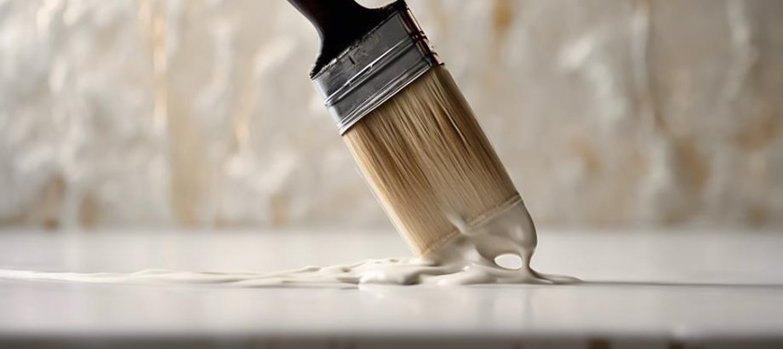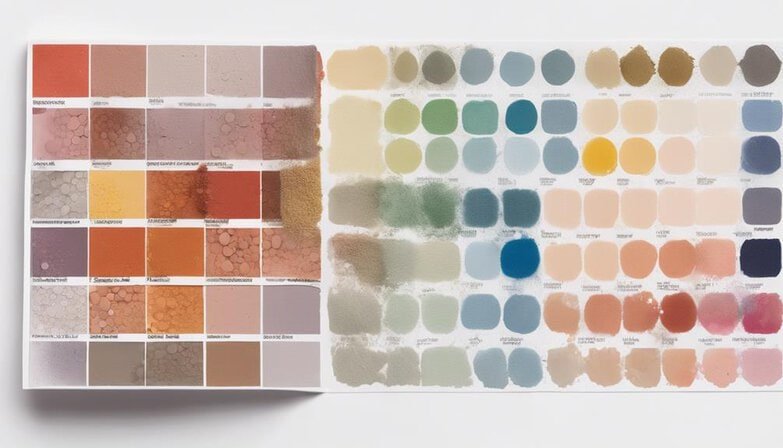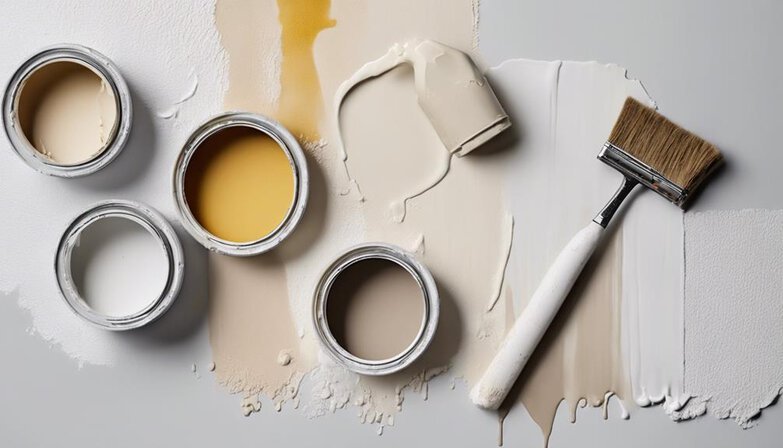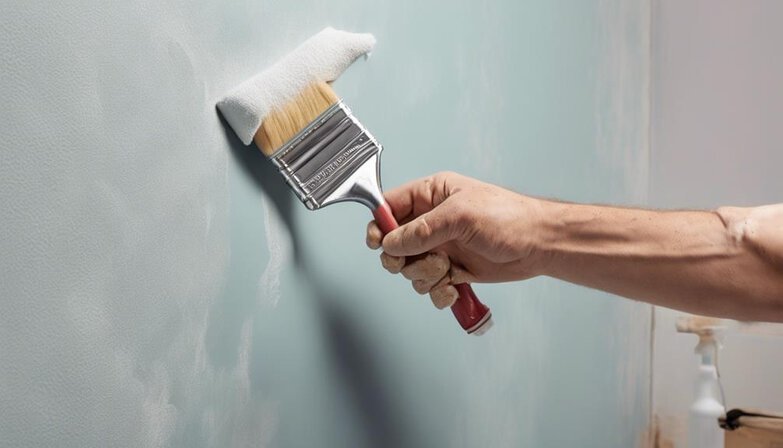Best Stain-Blocking Paints for Interiors

To achieve a successful, long-lasting finish on your interior painting project, you’ll want to choose a high-quality stain-blocking paint. Look for specialized polymers, resins, and pigments that improve stain resistance and durability. You can opt for oil-based, water-based, or eco-friendly choices, and consider primer paints for a combined primer and finish coat. Leading picks include Behr’s Premium Plus ULTRA, Kilz’s Original, and Zinsser’s BIN, which offer low-VOC, fast-drying, and high-performance benefits. By understanding the key ingredients and types of stain-blocking paints, you’ll be better equipped to make an informed decision and guarantee a flawless finish – and that’s just the beginning.
Key Takeaways
- Top stain-blocking paints include Behr’s Premium Plus ULTRA, Kilz’s Original, and Zinsser’s BIN for addressing interior stains and discoloration.
- Oil-based stain-blocking paints offer a durable finish, while water-based alternatives provide easier cleanup and faster drying times.
- Key ingredients to look for in stain-blocking paints include specialized polymers, resins, and pigments that enhance stain resistance and durability.
- Moisture-resistant formulas with mold and mildew protection are ideal for addressing water stains, while high-durability paints suit high-traffic areas.
Top Stain-Blocking Paints Reviewed
You can tackle tough interior stains with confidence using top-rated stain-blocking paints from brands like Behr, Kilz, and Zinsser, each offering unique benefits and applications.
When selecting a stain-blocking paint, you’ll want to take into account eco-friendly options, color choices, finish types, drying times, and brand comparisons.
Behr’s Premium Plus ULTRA Stain-Blocking Paint is a popular choice, offering a 100% acrylic latex formula that’s low-VOC and easy to clean up.
Kilz’s Original Stain-Blocking Paint is another top contender, featuring a fast-drying formula that’s ready for a second coat in just two hours.
Zinsser’s BIN Stain-Blocking Paint is a high-performance option that’s ideal for severe staining and discoloration.
With a range of finish types, including flat, eggshell, and semi-gloss, you can choose the perfect sheen for your project.
When comparing brands, take into account factors like drying times, which can range from 30 minutes to several hours.
By evaluating these key factors, you can choose the best stain-blocking paint for your specific needs and achieve professional-looking results.
With the right stain-blocking paint, you can say goodbye to pesky stains and enjoy a beautiful, even finish.
Types of Stain-Blocking Paints
Beyond choosing a specific brand, understanding the different types of stain-blocking paints available can further help homeowners and DIYers select the best product for their interior projects.
You’ll find oil-based options, which provide a hard, durable finish, and water-based alternatives, which are easier to clean up and dry faster. Eco-friendly choices are also available, made with natural ingredients and low VOCs.
When selecting a stain-blocking paint, consider the following options:
- Primer paints that combine a primer and finish coat in one
- Finish variations, such as flat, eggshell, satin, semi-gloss, and high-gloss
- Oil-based paints for trim work and furniture
- Water-based paints for walls and ceilings
Key Ingredients to Look For

Several key ingredients play a crucial role in the effectiveness of stain-blocking paints, and recognizing them helps homeowners choose the best product for their specific needs. When shopping for a stain-blocking paint, you’ll want to look for key ingredients that improve paint formulations and provide superior stain resistance. These ingredients often include specialized polymers, resins, and pigments that work together to create a durable, stain-resistant finish.
As you evaluate different products, also consider the application techniques and drying times associated with each paint. Some stain-blocking paints may require special application procedures or longer drying times to achieve the best results.
Be sure to read and follow the manufacturer’s instructions carefully to guarantee the best possible outcome. By taking the time to understand the key ingredients and application requirements of different stain-blocking paints, you’ll be able to choose the product that best meets your needs and achieve professional-looking results with minimal hassle.
Best Paints for Water Stains
When tackling water stains, choosing a paint specifically designed to hide and prevent water damage is crucial for a long-lasting, professional-looking finish. You’ll want to look for paints with moisture resistance and stain prevention properties.
Here are some key features to contemplate:
- Moisture-resistant formulas: Look for paints with additives that inhibit the growth of mold and mildew.
- Primer options: Think about using a stain-blocking primer to guarantee a smooth, even finish.
- Stain-preventing coatings: Some paints contain special coatings that prevent water stains from forming.
- Mold protection: Choose paints with mold-resistant properties to keep your walls healthy and clean.
Best Paints for Grease Stains

To combat grease stains, you’ll need a paint that’s specifically designed to conceal and withstand the discolored, oily residue left behind by cooking splatters or machinery spills.
When choosing a paint for grease stain prevention, consider kitchen paint options that are formulated to resist stains and wear. Look for paints with a high durability rating, as they’ll be better equipped to withstand the demands of a busy kitchen.
Before applying paint, make certain to follow surface preparation tips, such as cleaning the area thoroughly and applying a primer if necessary. This will guarantee a smooth, even finish and help the paint adhere properly.
If you’re concerned about the environmental impact of your paint choice, consider eco-friendly paints that are low in VOCs (volatile organic compounds) and made from sustainable ingredients.
Some top paint options for grease stains include epoxy-based paints, acrylic latex paints, and urethane-based paints. These paints offer excellent durability and stain resistance, making them ideal for high-traffic areas like kitchens.
When comparing paint durability, consider factors like scrub resistance and adhesion to guarantee you choose a paint that can withstand the demands of your kitchen.
Best Paints for Ceiling Stains
If grease stains on walls are a challenge, ceiling stains present their own set of obstacles, requiring paints that can effectively cover and prevent the recurrence of water spots, mildew, and discoloration.
In terms of ceiling stain solutions, you need to choose a paint that’s specifically designed for ceilings. Here are some key considerations:
- Choose a paint with a built-in primer to help cover common ceiling stains like water spots and discoloration.
- Select a paint with a high level of mildew resistance to prevent the growth of mold and mildew.
- Consider a paint with a flat or eggshell finish to minimize glare and reflections.
- Think about the color – white or light colors can help make ceilings appear higher, while darker colors can create a cozier atmosphere.
Tips for Application Success

Before you start painting, make sure you’ve prepared the surface properly, as stain-blocking paints work best on clean, dry surfaces that are free of dirt, grime, and old wax or grease.
Surface preparation is key to a successful application, so take the time to clean and sand the surface before painting.
When it’s time to paint, choose the right brush for the job. Natural-bristle brushes work best with oil-based stain-blocking paints, while synthetic brushes are better suited for water-based paints.
Apply the paint using smooth, even strokes, working in small sections to maintain even coverage.
Pay attention to drying times, as stain-blocking paints can take longer to dry than regular paints.
Make sure the area is well-ventilated, as the fumes from these paints can be strong. Keep windows and doors open, and use a fan to circulate the air.
Frequently Asked Questions
Are Stain-Blocking Paints Suitable for Use on Textured or Popcorn Ceilings?
You can use stain-blocking paints on textured or popcorn ceilings, but proper ceiling preparation is key to guarantee paint adhesion. Check texture compatibility initially, as some paints may not adhere well to certain textures.
Can Stain-Blocking Paints Be Used on Surfaces With Mildew or Mold?
You can use stain-blocking paints on surfaces with mildew or mold, but initially, you’ll need to treat the mildew and remove the mold using specialized techniques, then prepare the surface and follow specific paint application guidelines.
Do Stain-Blocking Paints Work on Stains Caused by Pet Accidents?
You’ll face challenges covering stains from pet accidents, but with the right stain-blocking paint, you can achieve effective stain removal and eliminate lingering pet odor; master application techniques to guarantee peak paint durability and color matching.
Are Stain-Blocking Paints Available in Low-Voc or Eco-Friendly Options?
You’ll find stain-blocking paints in low-VOC options and eco-friendly formulations that prioritize indoor air quality. When making product comparisons, consider factors like application techniques and coverage rates to guarantee a healthy and effective solution.
Can Stain-Blocking Paints Be Used on Surfaces Previously Painted With Lead-Based Paint?
You’ll need to take extra precautions when using stain-blocking paints on surfaces previously coated with lead-based paint, following strict lead paint safety guidelines, surface preparation, and adhesion techniques to minimize health risks and meet regulatory standards.
